The Evolution of Pop Music
As the volatile decade of the 1960s unfolded, pop music (including rock) changed to reflect additional social, cultural, and political shifts—while continuing to influence these aspects of American life as well. Authorities made further attempts to “tame” rock, concerned about its influence on teenagers. These attempts sparked resistance from defiant young people, many of whom embraced rock musicians from Great Britain who hadn’t toned down their style. As pop music continued to adapt, it spun off into several genres, including soul, folk, and psychedelic, as well as country, punk, grunge, and hip-hop.
The British Are Coming!
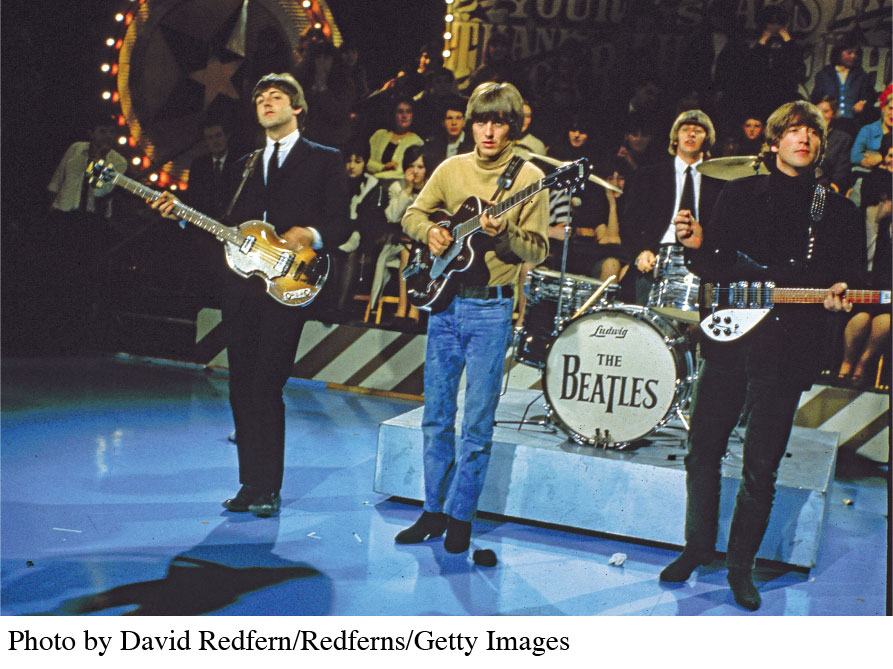
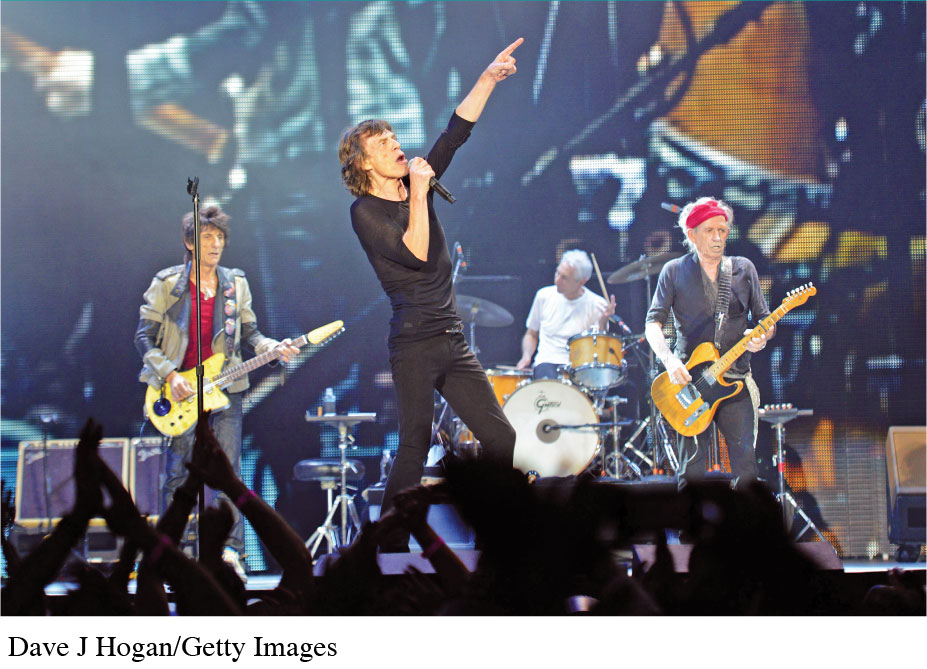
Rock and roll proved so powerful that it transformed pop music across national borders. For instance, in England during the late 1950s, the young members of the Rolling Stones covered blues songs by American artists Robert Johnson and Muddy Waters. And the young Beatles imitated Chuck Berry and Little Richard.
Until 1964, rock-and-roll recordings had traveled on a one-way ticket to Europe. Even though American artists regularly reached the tops of charts overseas, no British performers had yet appeared on any Top 10 pop lists in the United States. This changed virtually overnight in 1964, when the Beatles came to America with their mop haircuts and delivered pop interpretations of American blues and rock. Within the next few years, more British bands—the Kinks, the Who, the Yardbirds—produced hits that climbed the American Top 40 charts. Ed Sullivan, who booked the Beatles several times on his TV variety show in the mid-1960s, helped promote the group’s early success.
With the British invasion, the rock industry split into two styles of music. The Rolling Stones developed a style emphasizing gritty, chord-driven, high-volume rock, which would influence later bands that created glam rock, hard rock, punk, heavy metal, and grunge. Meanwhile, the Beatles presented a more accessible, melodic, and softer sound, which would eventually inspire new genres, such as pop rock, power pop, new wave, and alternative rock. The British groups’ success also demonstrated to the recording industry that older American musical forms, especially blues and R&B, could be repackaged as rock and exported around the world.
Motown: The Home of Soul
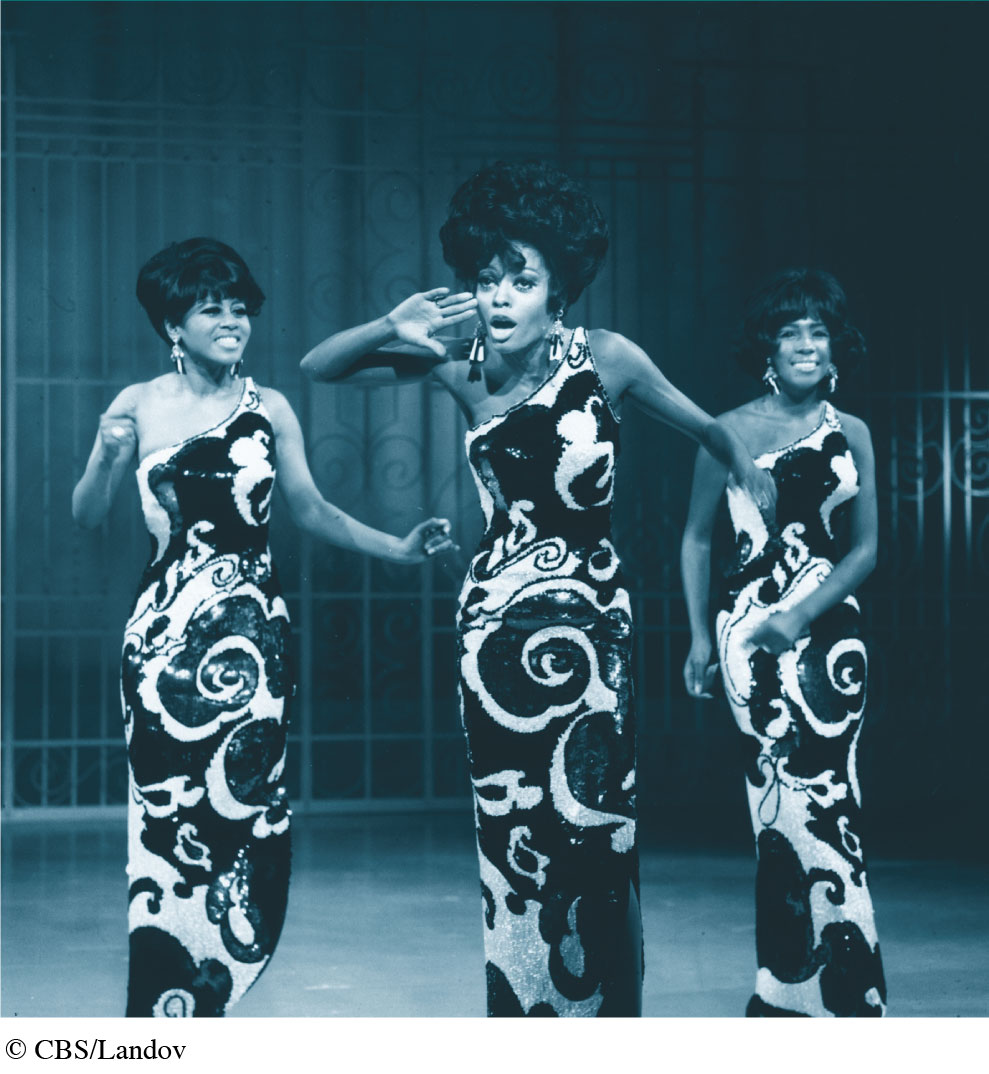
As rock attracted more and more devotees, it resurrected interest in the styles of music from which it had originated. Throughout the 1960s, black singers like James Brown, Aretha Franklin, Wilson Pickett, Otis Redding, and Ike and Tina Turner picked up on this interest, transforming the rhythms and melodies of older R&B, pop, and early rock and roll into what would become known as soul. These artists attracted large and racially diverse audiences, countering the British invaders with powerful vocal performances.
The most prominent independent label supporting black songwriters’ and performers’ work was Motown, started in 1959 by former Detroit autoworker and songwriter Berry Gordy. Motown signed many successful black artists and groups, including the Four Tops (“Baby I Need Your Loving”), the Marvelettes (“Please Mr. Postman”), Marvin Gaye (“What’s Going On”), and the Jackson 5 (“I’ll Be There”). But the label’s most successful group was the Supremes, featuring Diana Ross, which scored twelve No. 1 singles between 1964 and 1969 (including “Where Did Our Love Go” and “Stop! In the Name of Love”). The Supremes’ success showed Motown producers that songs emphasizing romance and featuring a danceable beat won far more young white fans than those trumpeting rebellion and political upheaval.
Folk and Psychedelic: Protest and Drugs
Popular music has always been both a product of and a shaper of its time. So it’s not surprising that the social upheavals of the 1960s and early 1970s—over Civil Rights, women’s rights, environmental protection, the Vietnam War, and the use of recreational drugs—found their reflections in rock music during these decades. By the late 1960s, many songwriters and performers spoke to their generation’s social and political concerns through two music genres: folk and psychedelic rock.
Folk Inspires Protest

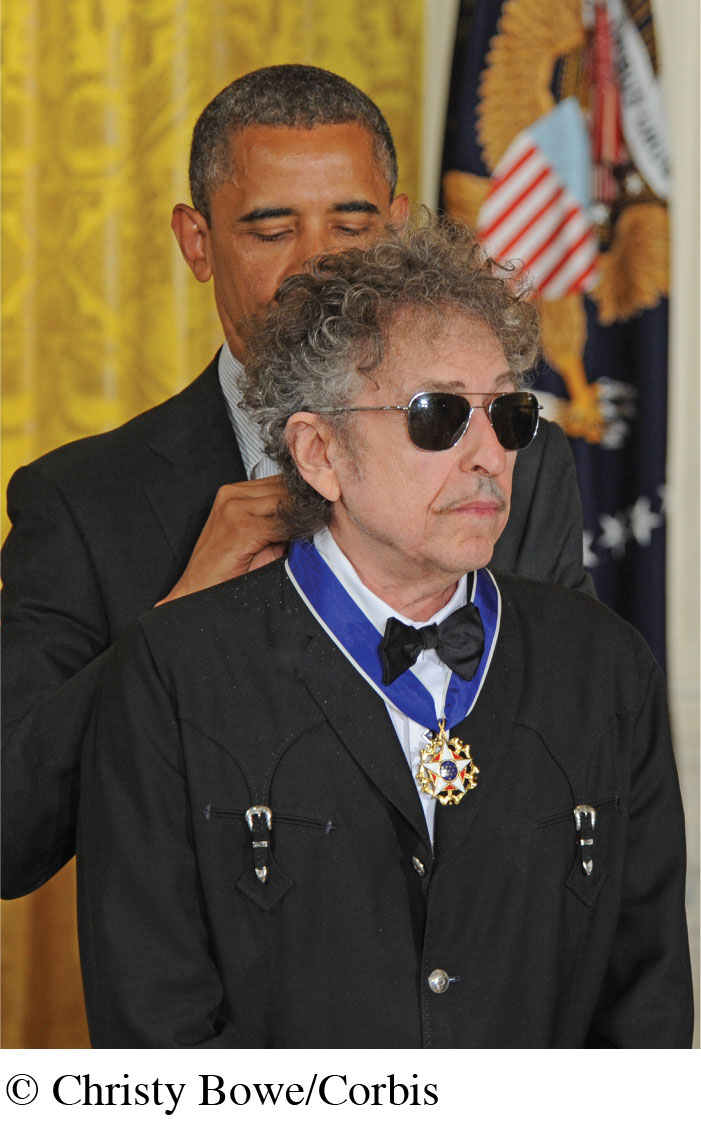
The musical genre that most clearly expressed pivotal political events of the time was folk, which had long served as a voice for social activism. Folk music exists in all cultures; it’s usually performed by untrained musicians and passed down mainly through oral traditions. With its rough edges and amateur quality, folk is considered a democratic and participatory musical form. During the 1930s, the work of Woody Guthrie (“This Land Is Your Land”) set a new standard for American folk music. Later, in the 1960s and 1970s, groups such as the Weavers, featuring labor activist and songwriter Pete Seeger, carried on Guthrie’s legacy. These newer groups inspired yet another crop of singer-songwriters—Joan Baez; Arlo Guthrie; Peter, Paul, and Mary; Phil Ochs; Bob Dylan—who took a stand against worrisome developments of the day, including industrialization, poverty, racism, and war.
Rock Turns Psychedelic
With the increasing use of recreational drugs by young people and the availability of LSD (not illegal until the mid-1960s), more and more rock musicians experimented with and sang about drugs during rock’s psychedelic era. Defining groups and performers of this era included newcomers like Jefferson Airplane, Big Brother and the Holding Company (featuring Janis Joplin), the Jimi Hendrix Experience, the Doors, and the Grateful Dead, as well as established artists like the Beatles and the Rolling Stones. These musicians believed they could enhance their artistic prowess by taking mind-altering drugs. They also saw the use of these drugs as a form of personal expression and an appropriate response to the government’s failure to deal with social and political problems, such as racism and America’s involvement in the Vietnam War.
After a surge of optimism that culminated in the historic Woodstock concert in August 1969, the sun set on the psychedelic era. In particular, some of psychedelic rock’s greatest stars died from drug overdoses, including Janis Joplin, Jimi Hendrix, and Jim Morrison of the Doors.
Punk, Grunge, and Alternative Rock: New Genres on the Horizon
As rock and roll moved from the edges of the American music scene into the mainstream, other genres arose to take its place on the fringes. While many people had considered rock a major part of the rebel counterculture in the 1960s, in the 1970s they increasingly viewed it as part of consumer culture. With major musical acts earning huge profits, rock had become just another product for manufacturers and retailers to promote, package, and profit from. According to critic Ken Tucker, this situation produced “faceless rock” performed by bands with “no established individual personalities outside their own large but essentially discrete audiences” of young white males.5 To Tucker, these “faceless” groups—REO Speedwagon, Styx, Boston, Journey, Kansas—filled stadiums and entertained the maximum number of people while stirring up the minimum amount of controversy. It was only a matter of time before new types of music—punk, grunge, and alternative rock—arose to challenge rock’s mainstream once more. Concurrently, an older genre—country music—rose to greater prominence, crossing over to gain more mainstream acceptance.

Punk Revives Rock’s Rebellious Spirit
Punk rock arose in the late 1970s to defy the orthodoxy and commercialism of the record business. Punk attempted to revive rock’s basic defining characteristics: simple chord structures that anyone with a few guitar lessons could master, catchy melodies, and politically or socially defiant lyrics. Emerging in New York City around bands such as the Ramones, Blondie, and Talking Heads, punk quickly spread to England, where a soaring unemployment rate and growing class inequality ensured the success of socially critical rock. Groups like the Sex Pistols, the Clash, the Buzzcocks, and Siouxsie and the Banshees sprang up and even scored Top 40 hits on the U.K. charts. Despite their popularity, the Sex Pistols—one of the most controversial groups in rock history—was eventually banned for offending British decorum.
Punk didn’t succeed commercially in the United States, in part because it was so hostile toward the commercialization of the mainstream music industry. However, it did help to break down the boys’ club mentality of rock, launching unapologetic and unadorned front women like Patti Smith, Joan Jett, Debbie Harry, and Chrissie Hynde. It also introduced all-women bands whose members not only wrote but also performed their own music. Many of these female groups made it into the mainstream. Through these and other innovations, punk reopened the door to experimentation at a time when the industry had turned music into a purely commercial enterprise.
Grunge and Alternative Reinterpret Rock
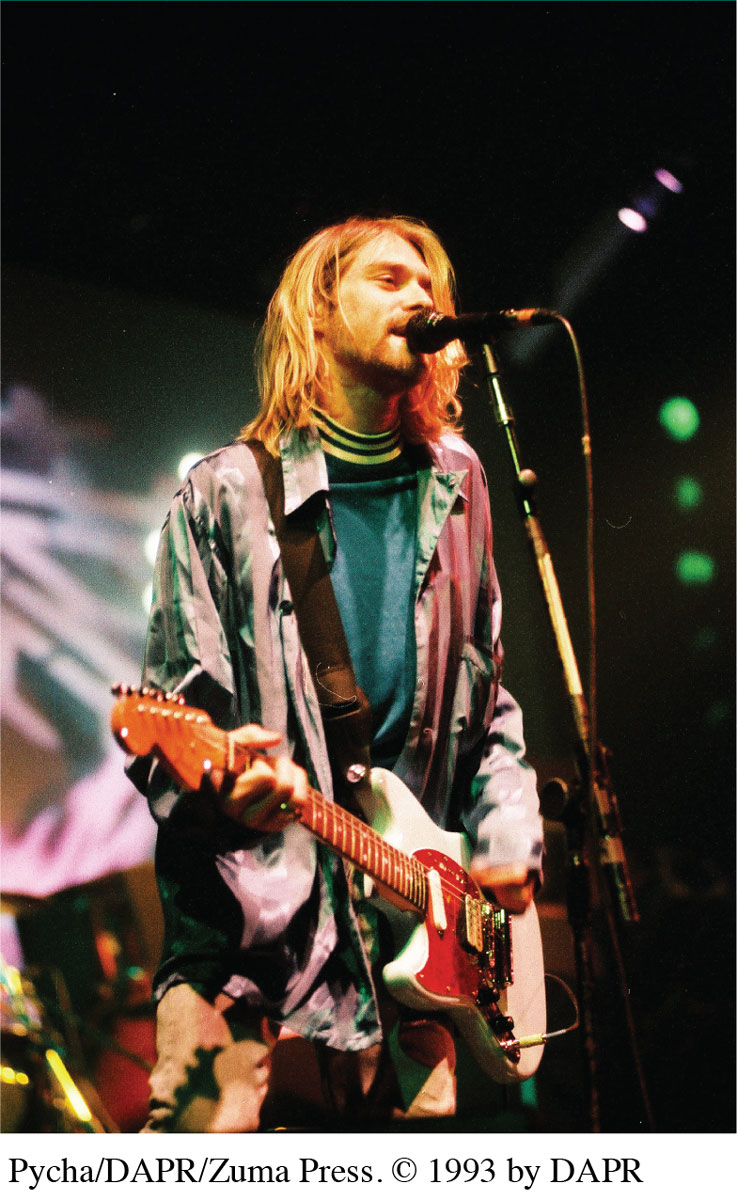
Building on the innovative spirit of punk, the grunge genre further transformed rock in the 1990s. Grunge got its name from its often-messy guitar sound and the torn jeans and flannel shirts worn by its musicians and fans. Its lineage traced back to 1980s bands like Sonic Youth, the Minutemen, and Hüsker Dü. In 1992, after years of limited commercial success, this younger cousin of punk finally broke into the American mainstream with the success of Nirvana’s “Smells Like Teen Spirit,” the hit single from the album Nevermind.
Some critics view punk and grunge as subcategories or fringe movements of alternative rock, even though grunge was far more commercially successful than punk. This vague label encompasses many types of experimental rock music, which offered departures from the staged extravaganzas of 1970s glam rock. Such music appealed chiefly to college students and twentysomethings and set itself apart from the sounds of Top 40 and commercial FM radio. The same is true of indie rock, a broad category of independent-minded rock music usually distributed by smaller record labels. This genre, which can be traced to 1980s punk and post-punk acts, has achieved greater commercial success in recent years.
Hip-Hop Redraws Musical Lines
With the growing segregation of radio formats and the dominance of mainstream rock by white male performers, the place of black artists in the rock world diminished from the late 1970s onward. By the 1980s, few popular black successors to Chuck Berry or Jimi Hendrix had emerged in rock, with artists like Prince and Lenny Kravitz exceptions more than the rule. These trends, combined with the rise of “safe” dance disco by white bands (the Bee Gees), black artists (Donna Summer), and integrated groups (the Village People), created a space for a new sound to emerge starting in the late 1970s: hip-hop, a term for the urban culture that includes rapping, cutting (or sampling) by deejays, breakdancing, street clothing, poetry slams, and graffiti art.


Similar to punk’s opposition to commercial rock, hip-hop music stood in direct opposition to the polished, professional, and often less political world of soul. Its combination of social politics, swagger, and confrontational lyrics carried forward long-standing traditions in blues, R&B, soul, and rock and roll.
Initially, the music industry saw it as a novelty destined to go nowhere. But by 1985, hip-hop had become a popular genre with the commercial successes of groups and artists like Run-DMC, the Fat Boys, LL Cool J, and Queen Latifah. Soon, white groups like the Beastie Boys and Linkin Park were combining hip-hop and hard rock, while some white artists (such as Eminem, Iggy Azalea, and Macklemore) were attracting huge followings by emulating black rap artists. This has not been without controversy, however, as some critics worry about a repeat of the appropriation of urban musical forms by white artists, robbing those original artists of both opportunities and their artistic voice. These concerns over race and cultural appropriation will likely continue to be a source of controversy.
Although hip-hop encompasses many different styles, its most controversial subgenre is probably gangster rap. In seeking to describe gang violence in America, gangster rap has been accused of inciting violence through its lyrics and the illegal activities of some of its performers. Gangster rap drew widespread condemnation in 1996 with the shooting death of Tupac Shakur, a rapper and convicted sex offender. Criticism mounted in 1997 after a drive-by shooter killed the Notorious B.I.G., who had dealt drugs as a youngster before becoming a rapper. Under pressure, the hip-hop industry softened its hard edges. Most prominently, artist Sean “Diddy” Combs developed a more danceable hip-hop that combined singing and rapping with musical elements of rock and soul. Today, hip-hop stars include artists such as 50 Cent, who emulates the gangster drama, and artists like Kanye West, Lupe Fiasco, Drake, and Talib Kweli, who often bring an old-school social consciousness to their performances.
From its origins in an urban American subculture, hip-hop has become a major part of mainstream global culture. Today, it’s big business, and its most successful practitioners have diversified from record labels to clothing lines, restaurants, and movie production companies.
The Country Road

Country music has attracted enough loyal listeners in its various forms to survive as a profitable sector of the recording industry since the early days of pop music. Though the many styles of country represent significant variations in the development of this musical form, they all share one element: the country voice, inflected by a twang or a drawl. In the late 1950s, the wilder honky-tonk sounds of country were tamed by a smoother style, inspired by the mellower songs of Elvis Presley. Replacing the fiddles, electric guitars, and nasal vocals of honky-tonk with symphonic strings, pitch-perfect background vocalists, and crooning stars like Jim Reeves and Patsy Cline, the emergent style would become known as the “Nashville sound.” This laid-back and toned-down form of country music reigned throughout the 1960s.6 In the 1970s, some singers and producers aimed for more mainstream acceptance. Lynn Anderson (“I Never Promised You a Rose Garden”), Charlie Pride (“Behind Closed Doors”), and Marie Osmond (“Paper Roses”) belted out hits that made the country idiom well liked in suburban America.7 By the late 1970s, this movement had spawned pop country, a form dedicated to generating hits that would score on both the pop and country charts, launching the careers of superstars Glen Campbell, John Denver, and Kenny Rogers. However, the genre would not peak until the 1990s, when “new country” attracted fresh throngs of fans. In 1989, Clint Black perfected the new country sound in his Killin’ Time album, and in 1992, Billy Ray Cyrus followed up Black’s triumph with the massive hit “Achy Breaky Heart.” Shania Twain and Faith Hill went on to sell platinum country albums in the 1990s, but Garth Brooks would be the star to break sales and concert attendance records during the decade, establishing a huge country market for years to come.